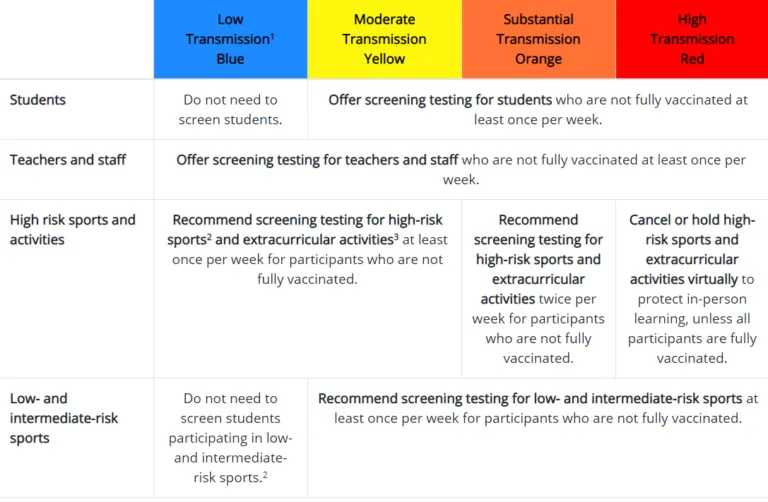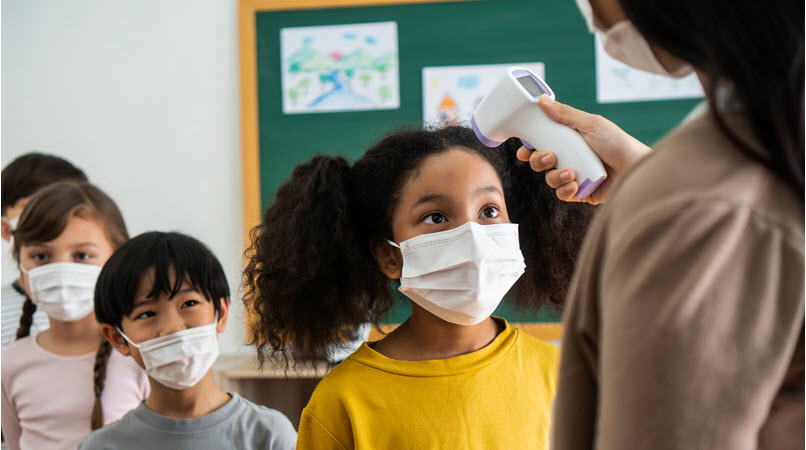It’s back-to-school time again for many students, and this year the usual stress for parents and teachers is amplified by safety concerns due to the ongoing COVID-19 pandemic. School districts need to react to the changing reality of the pandemic, understand applicable regulations for recording and reporting COVID-19 cases, and understand the role of better incident reporting in working with public health departments to track and address community spread.
In what follows, we’ll take a closer look at why incident reporting is an essential part of the safety toolkit for schools, because of applicability of federal and local regulations, as well as the general need to keep timely and accurate records of COVID-19 cases as a best management practice. While these examples are focused on schools in the United States and Canada, some of the considerations discussed here will be broadly applicable across regulatory jurisdictions.
Regulations relating to COVID-19 for Schools in the United States
In the United States, there are several sources of regulatory requirements and guidance related to the issue of COVID-19 cases in schools.
Federal and State OSHA: OSHA requires employers subject to its Recordkeeping Standard to record all occupational injuries and illnesses. The full obligations of the standard apply only to employers who have more than 10 employees in sectors within designated NAIC codes. Employers covered by the Occupational Safety and Health (OSH) Act outside of those criteria are partially exempt, meaning that they have no inherent responsibility to maintain OSHA recordkeeping documents such as Forms 300, 300A, and 301, but they would still need to maintain records if specifically requested to do so by OSHA or the Bureau of Labor Statistics. There also have a requirement to report several categories of serious occupational injuries and illnesses, including:
- Occupational fatalities (within 8 hours)
- Hospitalizations of one or more employees (within 24 hours)
- Amputations (within 24 hours)
- Incidents resulting in loss of eye (within 24 hours)
An employer who learns of an occupational injury or illness must report the incident to OSHA within the specified timeframe using any of the following methods:
- By telephone to the nearest OSHA Area Office during normal business hours
- By telephone to the 24-hour OSHA hotline at 1-800-321-OSHA (6742)
- Electronically at www.OSHA.gov
Looking at that list of serious occupational injuries and illnesses, we can see that the top two items can be associated with COVID cases if they are determined to be work-related. In guidance published on their page summarizing regulations relevant to COVID-19, OSHA clarifies the conditions under which a case of COVID-19 would be work-related and recordable as being:
- The case is a confirmed case of COVID-19 (see CDC information on persons under investigation and presumptive positive and laboratory-confirmed cases of COVID-19);
- The case is work-related (as defined by 29 CFR 1904.5); and
- The case involves one or more of the general recording criteria set forth in 29 CFR 1904.7 (e.g., medical treatment beyond first aid, days away from work).
Federal OSHA would not cover public schools, but states that have federally approved state OSHA plans would cover state and local workers, including public school staff. The same “partially exempt” status would apply to public school employers, meaning that they would still need to keep records if requested to do so, and would need to directly report cases involving an occupational fatality or a hospitalization.
One of the important points to remember here is that even though schools are not automatically required to keep OSHA injury and illness records, having a system for recording and documenting all cases makes it much more likely that you will be able to identify the serious incidents with the potential to become reportable as quickly as possible. That capability is not only important for meeting regulatory requirements, but also as a best safety management practice helpful to identify injury trends or areas that need attention.
Center for Disease Control and Prevention (CDC):
CDC has issued guidance on COVID-19 for a variety of different sectors of public and professional life, including educational institutions.
CDC’s “Guidance for COVID-19 Prevention in K-12 Schools” recommends that schools establish screening procedures for different groups of students and staff based on the activities they’re involved in, and the estimated potential for those activities to result in exposure to the SARS CoV-2 virus. This approach is summarized in the chart shown below.

Later in the guidance, the CDC also advises that school COVID plans should include “a mechanism to report all testing results, to the extent allowable by or consistent with applicable federal, state, or local laws and regulations, including privacy laws such as FERA, as required by the state or local health department.” Again, we can see that an easy and accessible mechanism for recording and reporting cases of COVID, whether among students or staff, is central to following recognized best practices for safety.
State/Local Requirements
Many state and local governments have also established their own requirements and guidance related to reporting of COVID cases. The relevance for educational settings is that these policies often require reporting of all cases, whether they happen among members of the school staff or among the students.
For example, the Ohio Department of Health states that “schools are required to report cases to their assigned Local Health Department who then report to the Ohio Department of Health.” The Department’s records separately tally the numbers of cases from staff and students.
Many public-school systems follow reporting guidelines established by their state’s department of public health, which are themselves often closely patterned on CDC guidance. Chicago Public Schools (CPS), follows the guidance of Illinois Department of Public Health (IDPH) to report cases of COVID-19 using a decision tree logic, while protecting the confidentiality of student and staff, and physical distancing measures recommended by CDC.
Regulations relating to COVID-19 for Schools in Canada
Of course, many countries aside from the US also have established regulatory requirements for reporting of occupational injuries and illnesses. Let’s look at Canada as an example, focusing on the implications for recording, tracking and reporting COVID-19 cases.
Occupational injury and illness reporting in Canada varies across its federal and provincial jurisdictions, as we can see in the chart provided on this page. A commonality is that employers need methods to ensure they’re informed about the occurrence of an occupational injury or illness, evaluate various measures of severity such as number of days or work missed, and report cases of threshold severity to the appropriate jurisdictional authority.
A Closer Look: Ontario’s Occupational Health and Safety Act
Provinces also have their own regulatory frameworks to address aspects of occupational health and safety for employers within their jurisdictions. In Ontario, Occupational Health and Safety Act (OHSA) regulations apply to most employers and workplaces. A guide to applicability created by OHSA specifically states that the Act applies to all persons who are employed as teachers as defined in the Education Act.
The provincial government of Ontario has stated on its “COVID-19 (coronavirus) and workplace health and safety” page that they consider the COVID-19 pandemic a “top concern” that affects the safety and health of workers, as regulated under OHSA. The same guidance establishes expectations for the reporting of occupational cases of COVID-19.
For example, it states:
“If an employer is advised that a worker has an occupational illness due to an exposure at the workplace or that a claim has been filed with the Workplace Safety and Insurance Board (WSIB), the employer must notify the Ministry of Labour, Training and Skills Development in writing within four days.”
One important factor that distinguishes Ontario’s safety requirements from corresponding requirements in the US under OSHA regulations generally, and the Recordkeeping Standard specifically, is the concern of applicability for public versus private schools. Teachers at public schools in the US would not be covered by federal OSHA jurisdiction, because federal OSHA does not apply to state and local workers, but they’d be covered by state OSHA plans if they work in a state that has one. Private schools would be subject to either federal or state OSHA requirements, depending on which has jurisdiction in their state, but as mentioned earlier, they would be partially exempt from OSHA Recordkeeping requirements.
In Ontario, by contrast, OHSA would cover all teachers in all school districts, whether they work in public or private schools. Many private schools may in turn be organized into a board under common management, which would centrally manage compliance with health and safety regulations.
Based on the above analysis, we can see that schools in Canada also need to take recording of COVID-19 cases seriously. While we’ve been focused here on employer/employee relationships within schools, a robust system for recording cases of COVID-19 could also help ensure that schools can comply with both injury and illness reporting requirements and provincial safety and health regulations. It would also allow them to quickly report cases to local public health authorities to help identify and respond to trends in community spread.
What are the Key Takeaways?
School districts face special challenges during this year’s back to school season. The high incidence rate of COVID cases, especially of the Delta variant, creates obligations for schools to have plans in place to protect the safety of staff and students, over and above the applicability of any specific regulation. It’s part of the social contract that a school makes as an employer with its workers, with the parents and guardians of their students, and with the larger community. Information they share regarding numbers of new cases helps municipal agencies such as public health departments respond more effectively to trends in community spread.
These considerations point toward the importance of an efficient incident reporting system, capable of quickly entering and tracking new COVID cases, accessing details for multiple cases from anywhere, and completing reports summarizing COVID cases reported over a given period of time.
Modern, cloud-based EHS software like VelocityEHS Incident Management, part of our Accelerate® platform, can provide the tools you need to better manage all occupational injuries and illnesses, including COVID-19 cases. You can report new incidents from anywhere, including hazard reports related to conditions in the workplace that require addressing, such as a shortage of disinfectants, as well as all injuries, illnesses, near hits/near misses, and first aid incidents. You can also easily attach associated documentation, perform trend analysis and generate reports, making it easy to share key information with everyone who needs to see it.
Now is the time to take stock of your existing incident management capabilities, and see where you may need better capabilities to provide the level of performance needed to keep students, staff and communities safe.
Let VelocityEHS Help
Ready to learn more about how our Incident Management solution can help you? Check out our solution landing page to learn more, and request a demo. And if you have questions, contact us anytime.
